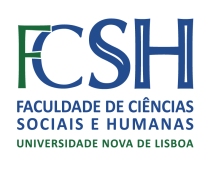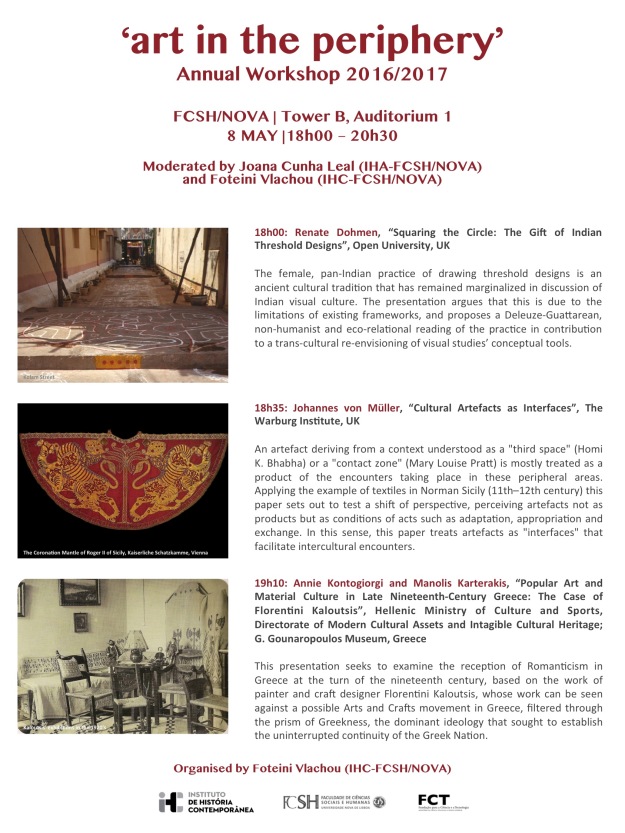
‘art in the periphery’ 4th session, April 3, 2017

‘art in the periphery’ 3rd session, March 6, 2017

Periphery as Negotiator of the Artistic Canon (few comments about Goa and its Christian Religious Art)
By Raluca E. Golesteanu, Polish Academy of Sciences / Humboldt University

Goa, the province located in the westernmost part of the Indian peninsula (the coastal area), was conquered in the sixteenth century by the Portuguese, becoming a land of the Portuguese crown. Around the mid of that century, the Jesuits started a massive campaign of Christianization. As a consequence, the destroyed Hindu temples were replaced by cathedrals adorned by statues of the Christian saints.
So far this is a classic metropolis-colony / power-submission story. It is just that the artists who were called to design the art following the Catholic canon, albeit some of them were converted to Christianity, kept as reference many features of Hindu aesthetics. The face traits, the gestures, the colors of the clothes bear strong Hindu influences. In fact, the products of this mix, including wooden statues of Virgin Mary and the Christ, Saint Francis of Assisi and Saint Ignatius of Loyola that can be seen at the National Gallery for Foreign Art, Sofia, were considered as representing a style in itself, named the Indo-Portuguese. The information on this display, which is part of the gallery’s permanent exhibition, states that this type of art ‘in its outer form was Christian, but in its inner essence, it remained profoundly Indianʼ.
This expression of a local identity, which, although eradicated institutionally, kept surviving in intimate matters like religion, was doubled by an equally interesting negotiation related to the artistic genre itself. As we mainly refer to the productions of the centuries following the imposition of Christianity in Goa (as we mentioned, sixteenth century), Baroque was a style creatively adapted by the local artists who were far from the places where Baroque art was in vogue. The cathedrals and the statues they were building and carving in the remote places of the province itself were distant from Western Europe but also from the Goan centre that exhibited other samples of Baroque art. In other words, the local artists and craftsmen emulated the Baroque style by putting into play their representation of what was the Baroque art as they simply lacked the contact with the original. The result is a new art that brings its own interpretation of the ideas and values accompanying the culture of Baroque and of the related currents.
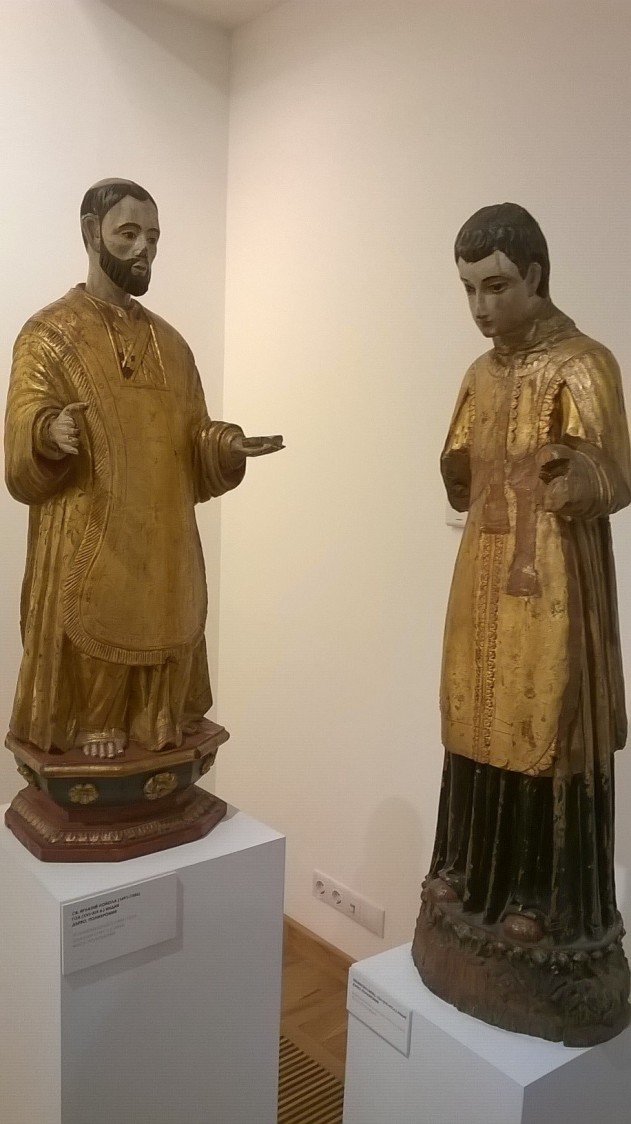
In short, the art of Goa illustrates in the best possible way the dynamics born around the center-periphery equation. Firstly, it is never a simple, unidirectional process; secondly, the imitation, if it occurs, is a highly original one, influenced by local traditions; thirdly, the negotiation by the periphery/colony of the model (artistic, political, social) imposed by the metropolis results in an alternative model. In the end, this alternative model, imbued with local (peripheral) features as it is, becomes a canon by itself, competing with the original.

Unfortunately, the museum does not have a site of its own, or a page dedicated to this section, at least in English; it is included in the national gallery directory: http://www.nationalartgallerybg.org/index.php?l=95
The pictures are not perhaps of the best quality, being taken without flash light, but they hopefully give an idea of what has been stated here.
(text originally published in: https://rgolesta.wordpress.com/2016/07/20/periphery-as-negotiator-of-the-artistic-canon-few-comments-about-goa-and-its-christian-religious-art/)
‘art in the periphery’ December 6, 2016 (updated): Nuno Senos + Sofia Katopi
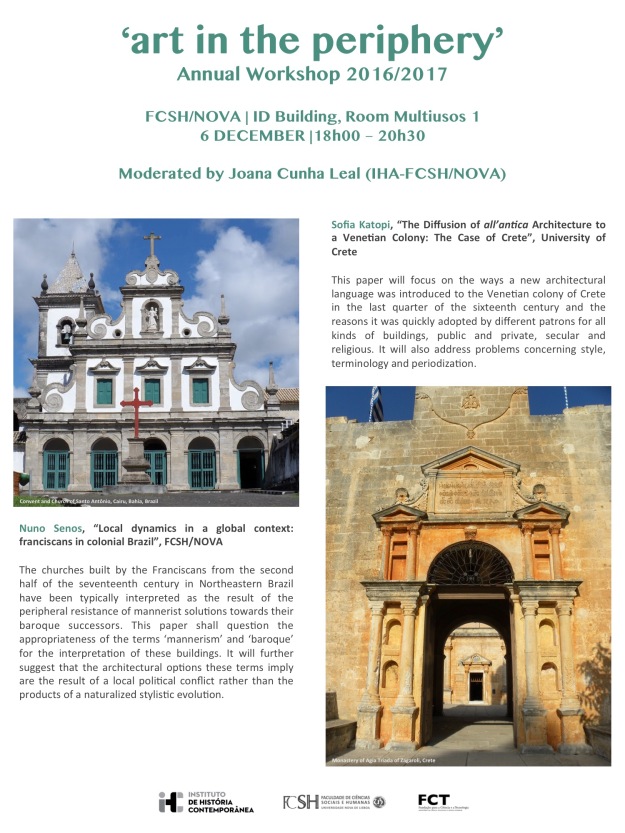
‘art in the periphery’ 2016/2017: updated program
.
November 14, 2016
18.00-18.40 Arthur Valle, “Afro-Brazilian Art and Material Culture: Persecution, Incarceration, Iconoclasm”, Universidade Federal Rural do Rio de Janeiro
18.40-19.20 Inna Pravdenko, “South American painters in the salons of the Société Nationale des Beaux-Arts (1890-1899)”, Institute for Transtextual and Transcultural Studies, Université Jean Moulin Lyon 3
19.20-20.00 Debate
December 6, 2016
18.00-18.40 Nuno Senos, “Local Dynamics in a Global Context: Franciscans in Colonial Brazil”, FCSH, Universidade Nova de Lisboa
18.40-19.20 Sofia Katopi, “The Diffusion of all’antica Architecture to a Venetian Colony: The Case of Crete”, University of Crete
19.20-20.00 Debate
March 6, 2017
18.00-18.35 Joris van Gastel, “Materiality at the Periphery. The Troubled Historiography of Baroque Naples”, Bibliotheca Hertziana, Max Planck Institute for Art History, Rome
18.35-19.10 Mihnea Alexandru Mihail, “Art in the ‘Periphery’ and the Domination of Style in the Geography of Art. The Case of the Hungarian Kingdom in the Fourteenth and Fifteenth Centuries”, National University of Arts, Bucharest
19.10-19.45 Gregor Taul, “Twentieth-century Mural Painting from Capitalist and Socialist Peripheries”, The Lisbon Consortium
19.45-20.30 Debate
April 3, 2017
18.00-18.40 Shelley Hornstein, “Views from the Margins: Albert Kahn, Archives of the Planet (1908-1929), and Borderlands”, York University, Toronto
18.40-19.20 Nikki Petroni, “Maltese Modern Art History and the Search for Identity”, University of Malta
19.20-20.00 Debate
May 8, 2017
18.00-18.35 Renate Dohmen, “Squaring the Circle: The Gift of Indian Threshold Designs”, The Open University, UK
18.35-19.10 Johannes von Müller, “Cultural Artefacts as Interfaces”, The Warburg Institute
19.10-19.45 Annie Kontogiorgi and Manolis Karterakis, “Popular Art and Material Culture in Late Nineteenth-Century Greece: The Case of Florentini Kaloutsis”, Hellenic Ministry of Culture and Sports, Directorate of Modern Cultural Assets and Intagible Cultural Heritage; G. Gounaropoulos Museum
19.45-20.30 Debate
June 5, 2017
18.00-18.35 Elena Stylianou and Nicos Philippou, “Greek-Cypriot Locality: (Re) Defining our Understanding of European Modernity”, European University Cyprus; University of Nicosia
18.35-19.10 Birgit Hopfener, “Disjunctive Contemporaneity. Artistic Narrative Cartographies of Transcultural and Art-historical Self-positioning”, Heidelberg University
19.10-19.45 Fernando Loffredo, “Connecting Peripheries across the Spanish Empire: Sculpture and Devotion between 17th Century Peru and Sicily”, Andrew W. Mellon Postdoctoral Fellow, Center for Advanced Study in the Visual Arts, National Gallery of Art
19.45-20.30 Debate
.
moderated by Joana Cunha Leal (Instituto de História da Arte, FCSH-NOVA) & Foteini Vlachou (Instituto de História Contemporânea, FCSH-NOVA)
organized by Foteini Vlachou (postdoctoral fellow, Instituto de História Contemporânea, FCSH-NOVA; researcher, Instituto de História da Arte, FCSH-NOVA)
venue: Auditório 1, Torre B, Faculdade de Ciências Sociais e Humanas, Universidade Nova de Lisboa (Av. de Berna, 26-C)
‘art in the periphery’ 2nd session, December 6, 2016
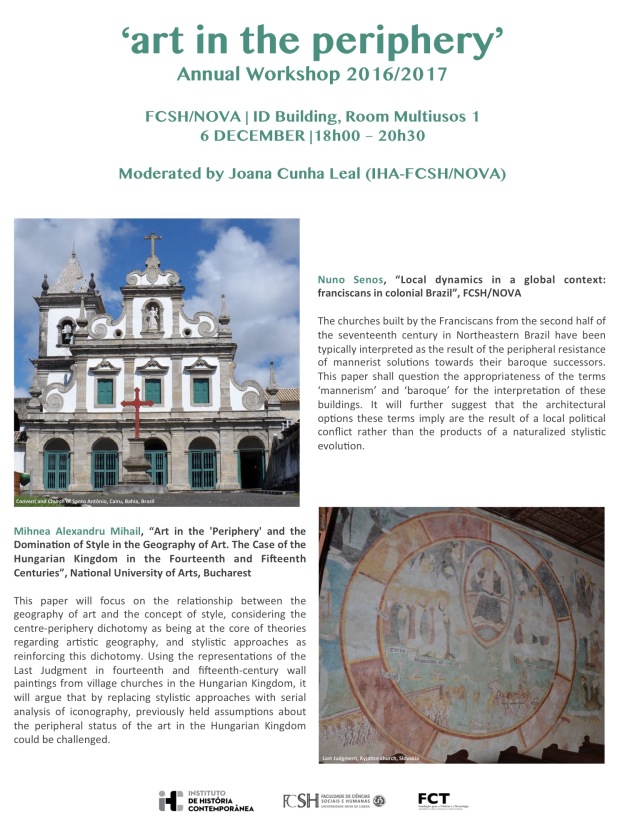
Robert Winthrop Chanler: Discovering the Fantastic
By Gina Wouters, Vizcaya Museum and Gardens

Photograph of Robert Winthrop Chanler, c. 1900, Private Collection
Robert Winthrop Chanler: Discovering the Fantastic, co-published by Vizcaya Museum and Gardens, and the Monacelli Press (released May 2016), is the first publication on the artist since his death. Although Chanler moved within a network of well-known artists (he has been portrayed by Man Ray and Carl van Vechten among others) and he received a steady number of commissions from high profile patrons, after his death he was marginalized by an art-historical discourse that centered on a singular path to modernity, as well as owing to practical difficulties regarding accessibility to his works.
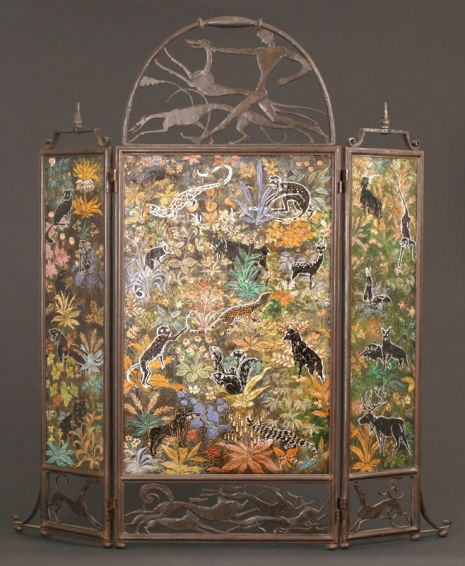
Robert Winthrop Chanler and Hunt Diederich, Mille Fleurs, 1919, Private Collection
The introduction to the book follows the trajectory of Chanler’s ascent as an artist and his fading from the public eye after his death. The fact that he commercially labeled himself as an interior decorator and his preferred medium was the screen –a decorative and thus “lesser art form”– are without doubt some of the factors behind his obscurity.
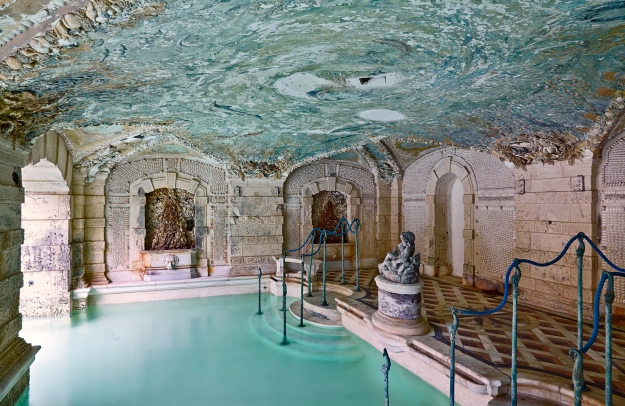
Robert Winthrop Chanler, Swimming Pool grotto at Vizcaya Museum and Gardens, 1916, Miami, Florida
Chanler had a penchant for altering spaces, whether through the immersive qualities his architectural interiors impart, or by way of a movable yet space-defining object such as the screen. The screens are often two sided and represent a variety of worlds, aquatic, avian, celestial and terrestrial. Chanler’s work is largely absent from the public eye, save for the swimming pool ceiling at Vizcaya Museum and Gardens in Miami, Florida and the Breakfast room at Coe Hall in Long Island, New York. These are both complex architectural spaces that present themselves in a compromised state due to the preservation conundrums his architectural works present.

Robert Winthrop Chanler, Vizcayan Bay, 1920, Vizcaya Museum and Gardens, Miami, Florida
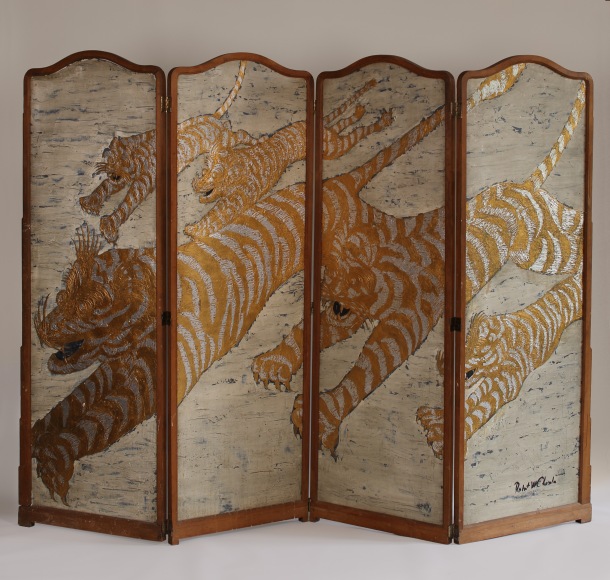
Robert Winthrop Chanler, Tigers, no date, Private Collection
Chanler’s dozens of screens are for the most part in private collections, largely handed down to descendants from those who commissioned them directly from the artist in the 1910s and 1920s. Or they are buried deep in museum storage like works in the collections of the Smithsonian American Art Museum, Brooklyn Museum and Whitney Museum of American Art. Only the Metropolitan Museum of Art has Chanler’s Porcupines and Nightmares panel in open storage in the Henry R. Luce Galleries.
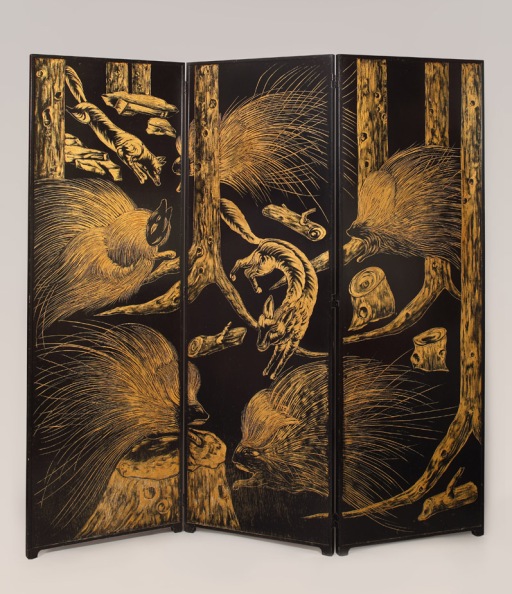
Robert Winthrop Chanler, Porcupines and Foxes, no date, Private Collection
Within the art historical context, Robert Winthrop Chanler’s fame lays in his monumental participation in the 1913 International Exhibition of Modern Art, popularly known as The Armory show, which was held in New York City, Boston, and Chicago. His work covered the walls of Gallery A the first space all guests would enter, which was dedicated to American Sculpture and Decorative Art. Not only did he show over a dozen works, as new research in the publication reveals, but he was also an important patron of his European peers, purchasing works by Odilon Redon, Constantin Brâncuşi and Amadeo de Souza Cardoso. As Laurette McCarthy writes, the works by the latter two were regarded as “extreme and revolutionary. Chanler’s acquisition of these works would have been thought quite daring and placed him in a relatively small circle of those who bought modern art from the show.”
- Robert Winthrop Chanler, Fireplace at Gertrude Vanderbilt Whitney’s Studio, 1918, New York City
- Robert Winthrop Chanler, Bedroom at Gertrude Vanderbilt Whitney’s Studio, 1912, Long Island
The monumentality of Chanler’s work and the immersive experiences they impart made him into a highly sought after artist in his years, yet the complexity and fixity of the architectural spaces and the often times immobility of his enormous screens hampered anyone other than the select strata they were created for to encounter them. Although Chanler embraced modernist ideals during their nascent years in the United States, his work became outdated after the bold direction of post-war Abstract Expressionism left his work out of vogue.

Robert Winthrop Chanler, Before the Wind, 1919, Private Collection
Essays in the publication cover aspects of his life and work and focus on the 1913 Armory Show, Chanler’s workshop at the House of Fantasy, Gilded Age patrons and commissions, patronage by Gertrude Vanderbilt Whitney, and preservation challenges his works present. Chanler’s decorative work has been peripheral to the artistic canon for over eighty years and this publication is his first return to the public eye. Hopefully, the research presented in the book will catalyze scholars and provide a springboard for continued research.
‘art in the periphery’ 1st session, November 14, 2016

‘art in the periphery’ annual workshop 2016/2017: program
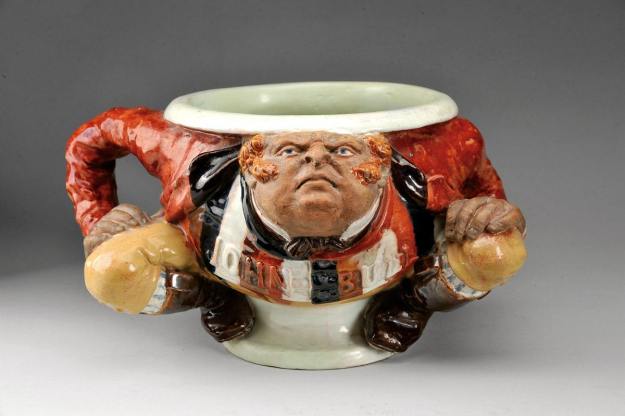
Rafael Bordalo Pinheiro, Chamber-pot in the shape of John Bull, c. 1890-1900, red clay, 23 x 29 x 41 cm, Museu da Cerâmica – Caldas da Rainha
November 14, 2016
18.00-18.40 Arthur Valle, “Afro-Brazilian Art and Material Culture: Persecution, Incarceration, Iconoclasm”, Universidade Federal Rural do Rio de Janeiro
18.40-19.20 Inna Pravdenko, “South American painters in the salons of the Société Nationale des Beaux-Arts (1890-1899)”, Institute for Transtextual and Transcultural Studies, Université Jean Moulin Lyon 3
19.20-20.00 Debate
December 6, 2016
18.00-18.40 Nuno Senos, “Local Dynamics in a Global Context: Franciscans in Colonial Brazil”, CHAM-FCSH, Universidade Nova de Lisboa
18.40-19.20 Mihnea Alexandru Mihail, “Art in the ‘Periphery’ and the Domination of Style in the Geography of Art. The Case of the Hungarian Kingdom in the Fourteenth and Fifteenth Centuries”, National University of Arts, Bucharest
19.20-20.00 Debate
March 6, 2017
18.00-18.40 Joris van Gastel, “Materiality at the Periphery. The Troubled Historiography of Baroque Naples”, Bibliotheca Hertziana, Max Planck Institute for Art History, Rome
18.40-19.20 Gregor Taul, “Twentieth-century Mural Painting from Capitalist and Socialist Peripheries”, The Lisbon Consortium
19.20-20.00 Debate
April 3, 2017
18.00-18.40 Shelley Hornstein, “Views from the Margins: Albert Kahn, Archives of the Planet (1908-1929), and Borderlands”, York University, Toronto
18.40-19.20 Nikki Petroni, “Maltese Modern Art History and the Search for Identity”, University of Malta
19.20-20.00 Debate
May 8, 2017
18.00-18.35 Renate Dohmen, “Unsquaring the Circle: Considering Indian Threshold Designs”, The Open University, UK
18.35-19.10 Annie Kontogiorgi and Manolis Karterakis, “Popular Art and Material Culture in Late Nineteenth-Century Greece: The Case of Florentini Kaloutsis”, Hellenic Ministry of Culture and Sports, Directorate of Modern Cultural Assets and Intagible Cultural Heritage; G. Gounaropoulos Museum
19.10-19.45 Johannes von Müller, “Cultural Artefacts as Interfaces”, The Warburg Institute
19.45-20.30 Debate
June 5, 2017
18.00-18.35 Elena Stylianou and Nicos Philippou, “Greek-Cypriot Locality: (Re) Defining our Understanding of European Modernity”, European University Cyprus; University of Nicosia
18.35-19.10 Birgit Hopfener, “Disjunctive Contemporaneity. Artistic Narrative Cartographies of Transcultural and Art-historical Self-positioning”, Heidelberg University
19.10-19.45 Fernando Loffredo, “Connecting Peripheries across the Spanish Empire: Sculpture and Devotion between 17th Century Peru and Sicily”, Andrew W. Mellon Postdoctoral Fellow, Center for Advanced Study in the Visual Arts, National Gallery of Art (to be confirmed)
19.45-20.30 Debate
.
moderated by Joana Cunha Leal (Instituto de História da Arte, FCSH-NOVA) & Foteini Vlachou (Instituto de História Contemporânea, FCSH-NOVA)
organized by Foteini Vlachou (postdoctoral fellow, Instituto de História Contemporânea, FCSH-NOVA; researcher, Instituto de História da Arte, FCSH-NOVA)
venue: sala Multiusos 1, edifício I&D, Faculdade de Ciências Sociais e Humanas, Universidade Nova de Lisboa (Av. de Berna, 26-C)
.

